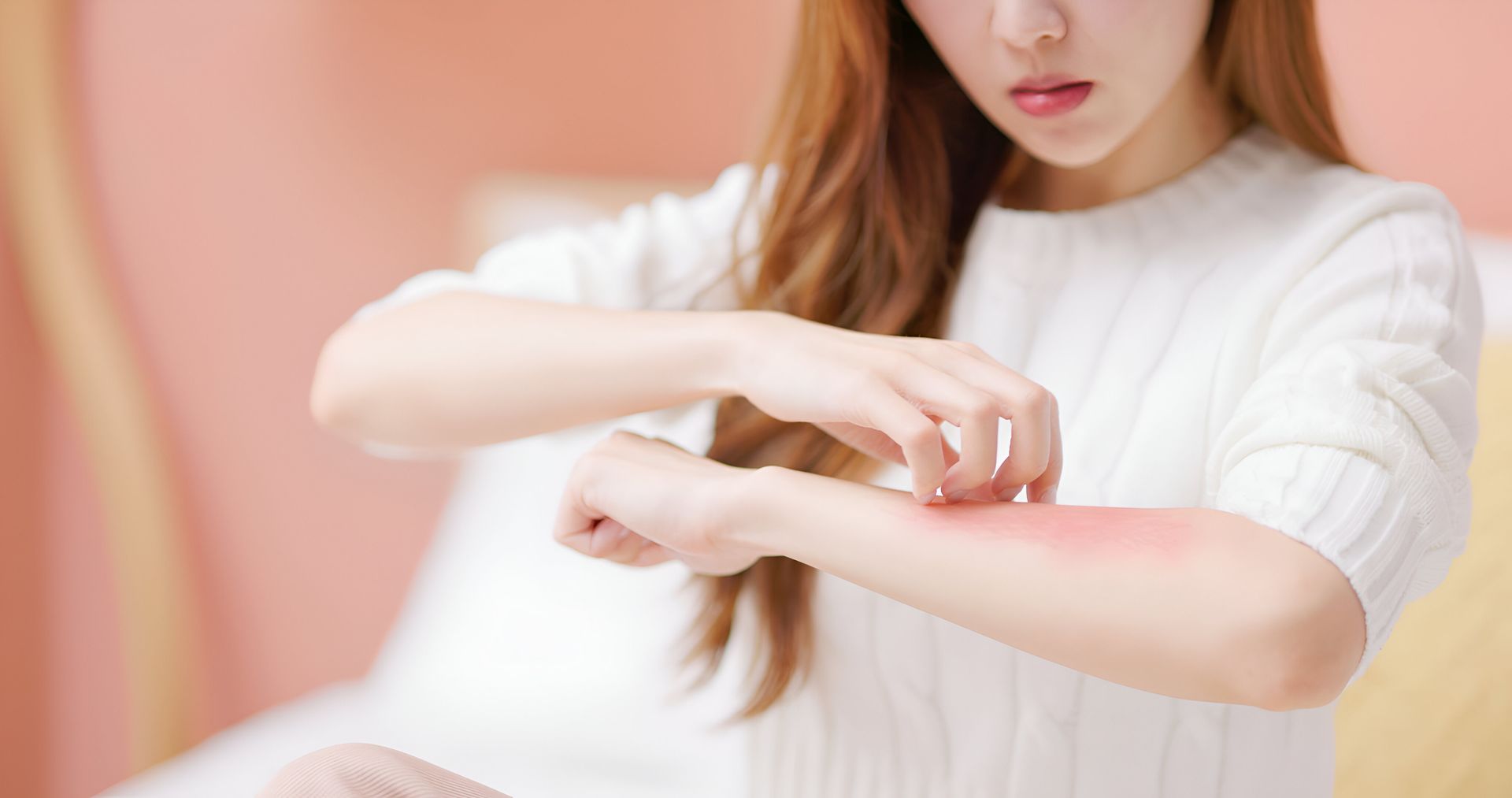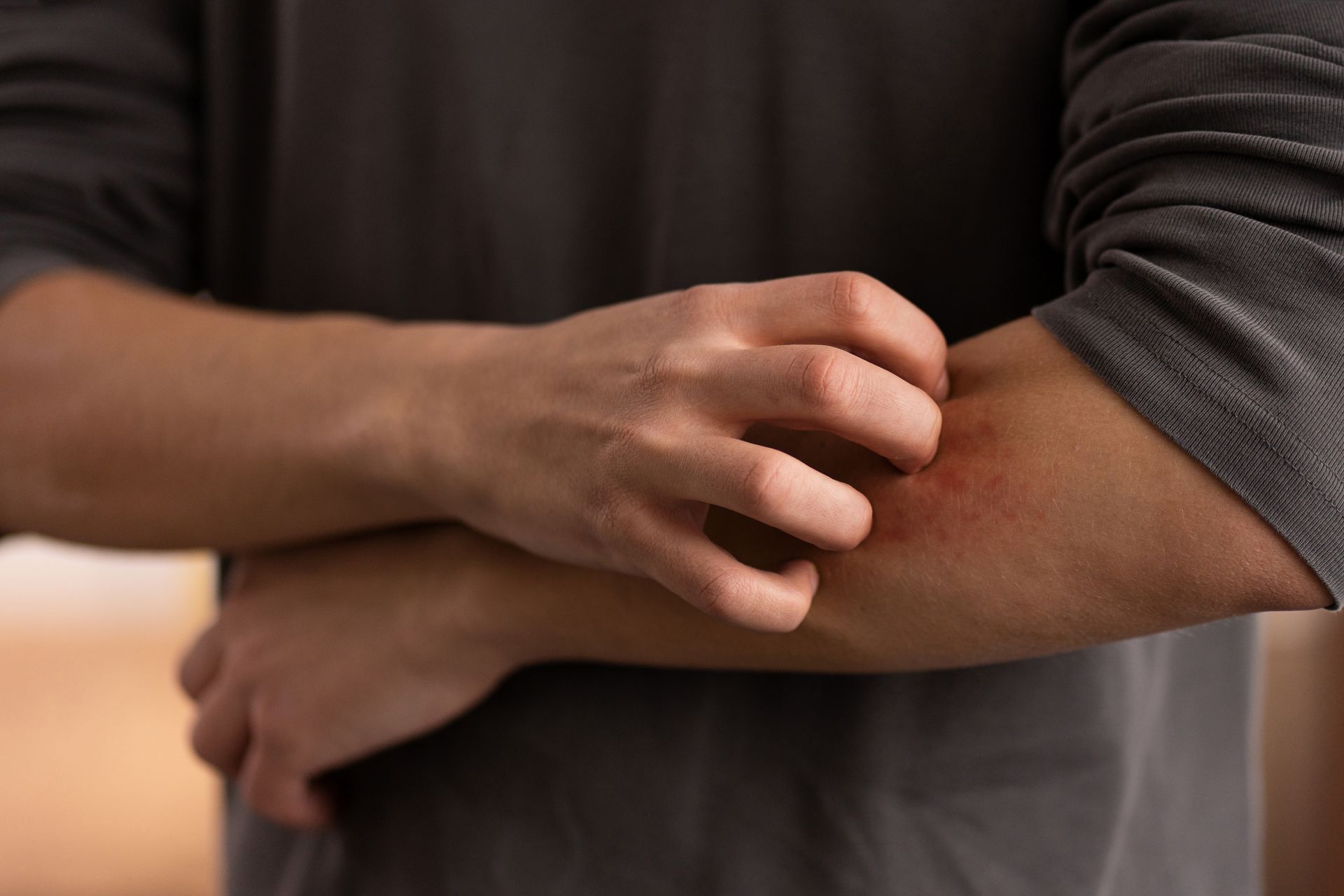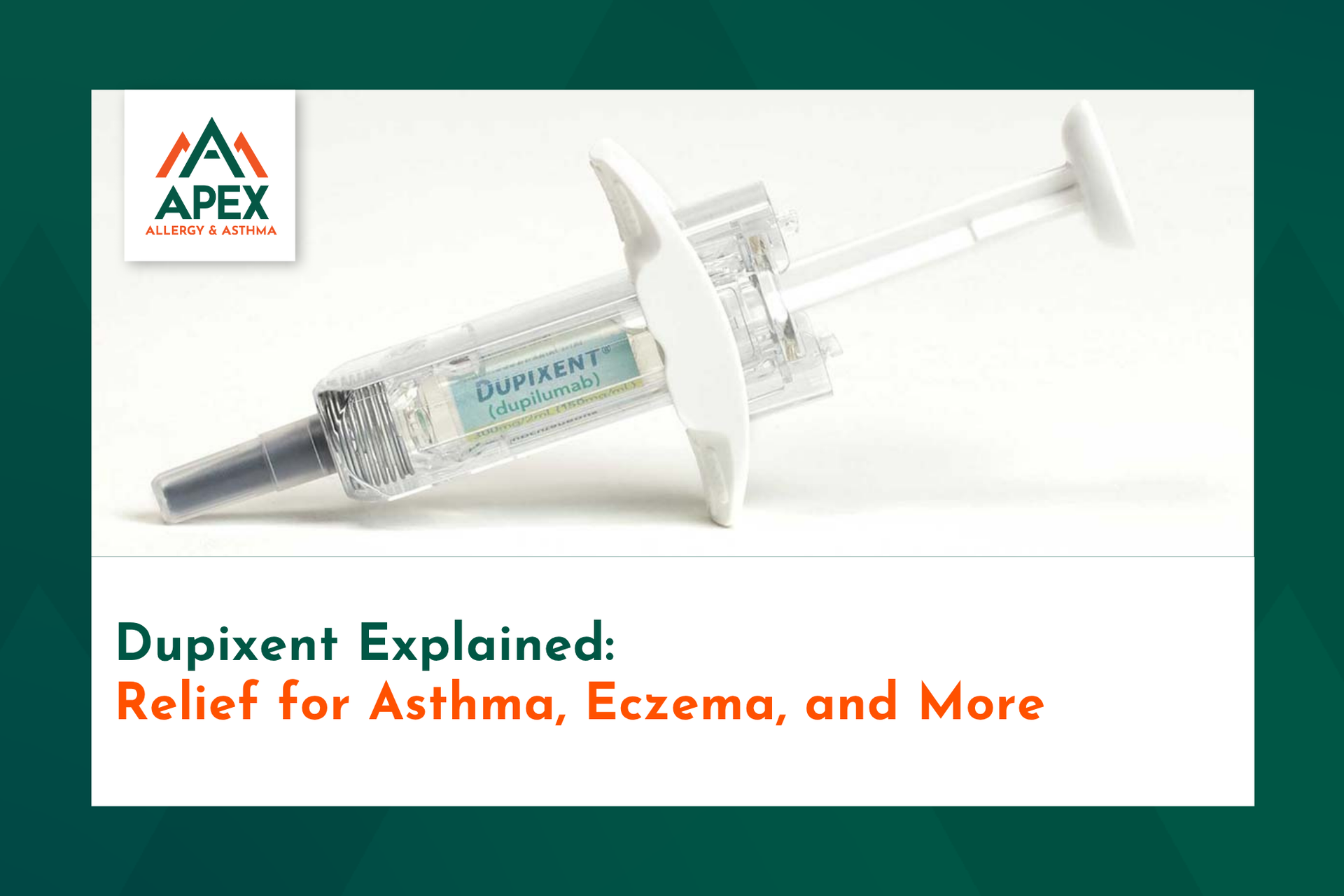Ever had itchy, red bumps on your skin that seem to come out of nowhere?
Hives (also called urticaria) are those raised, itchy welts that can pop up anywhere on your body. They might show up after you eat something, feel stressed, or sometimes for no reason at all. While they can be very uncomfortable, hives typically go away on their own within hours or days.
But if they keep coming back or last for weeks, you're probably feeling frustrated or concerned and looking for answers. At
Apex Allergy & Asthma, we can help you identify what triggers your hives and what will help provide relief.
Ready to understand what's happening with your skin and what you can do about it?
Don’t Let Hives Take Over Your Life
Schedule a Consultation
What Are Hives?
Hivesare itchy, raised bumps that appear on the skin as part of the body’s immune response. While many people associate them only with allergies, allergic reactions are just one of several possible causes. Hives can also result from stress, infections, temperature changes, or other non-allergic triggers. They are typically:
- Red, raised welts that may hurt or sting.
- Bumps as small as a pinprick or as large as a softball.
- Turning white when pressed at the center (doctors call this "blanching").
- Bumps that last 24 hours or less.
Visually, hives can resemble rashes, but they’re not exactly the same. The difference between hives and rashes primarily lies in their appearance and behavior.
Rashes are often flat or scaly, do not blanch under pressure, and may involve dry, peeling, or cracked skin.
How Common Are Hives?
You're definitely not alone if you've had hives. According to the American College of Allergy, Asthma, & Immunology (ACAAI), 20% of Americans get them at some point in their lives. Meanwhile, roughly 1.6 million Americans get diagnosed with chronic spontaneous urticaria (CSU) at any given time.
- Chronic hives tend to be more common in adults over 40 years old.
- Women are twice as likely as men to suffer from chronic hives.
- At least one in 100 people develops chronic hives each year.
Types of Hives
It’s easy to think that all hives are the same, but there are actually two major types depending on how long the hives last. Here's a breakdown:
It’s still not exactly clear what causes chronic hives in adults, as most cases remain spontaneous. However, certain factors can contribute to the occurrence of hives.
What Are the Causes of Hives?
Your body develops hives for a variety of reason. Understanding what triggers your hives symptoms is key to managing them better.
Allergic Triggers
These can prompt your immune system to overreact to something it perceives as harmful.
Symptoms: Usually appear within minutes to two hours after exposure, often accompanied by other allergy symptoms, such as a runny nose, watery eyes, or upset stomach.
Common Foods That Can Cause Hives:
- Shellfish (shrimp, crab, lobster, clams)
- Tree nuts (walnuts, almonds, cashews)
- Peanuts
- Eggs
- Milk and dairy products
- Wheat
- Soy
- Fish
What to watch for:
Hives caused by a food allergy can lead to mouth and throat itching, lip swelling, and skin reactions. They typically show up quickly after eating the trigger food.
Medications Linked To Hives:
Some medications may cause allergic reactions in certain individuals, resulting in hives. These medications include:
- Antibiotics (penicillin, sulfa drugs)
- Pain relievers (aspirin, ibuprofen, naproxen)
- Blood pressure medications (ACE inhibitors)
- Contrast dyes used in medical imaging
- Vaccines (rare but possible)
What to watch for: Reactions that happen within minutes or sometimes days after taking the medication. Always tell your doctor if you have any drug allergies.
Non-Allergic Triggers
These don't involve your immune system but can still cause hives.
Symptoms: May develop more slowly and last longer than allergic hives. Non-allergic triggers are often harder to pinpoint.
Stress and Emotional Factors
Stress can prompt your body to release cortisol, which can cause inflammation, including hives. Mental and emotional stress can sometimes precede the onset of chronic hives and can even exacerbate the symptoms.
What happens: Stress releases chemicals in your body that can trigger hives even without an allergen.
Environmental Triggers
- Temperature changes (hot or cold weather, hot showers)
- Sunlight or UV rays
- Pressure from tight clothing, belts, or sitting
- Vibration
- Exercise or sweating
- Chemicals in soaps, detergents, or perfumes
Underlying Medical Conditions
Sometimes hives are a sign of something else going on in your body.
Autoimmune Disorders
About 30% to 50% of chronic hives cases are triggered by the body's own immune system attacking healthy cells and tissues. The most common autoimmune condition involves developing an antibody against the allergic antibody, but could also be associated with thyroid disease, rheumatoid arthritis, and lupus.
What to watch for:
Hives that keep coming back without a clear trigger, especially if you have other symptoms like joint pain, fatigue, or changes in weight.
Infections That Can Cause Hives:
Both viral and bacterial infections can trigger hives. These include:
- Viral infections (common cold, flu, hepatitis)
- Bacterial infections (strep throat, UTIs)
- Fungal infections
- Parasitic infections
What happens: Chronic underlying infection can sometimes precede the onset of chronic hives. Your body's fight against the infection can trigger hives as a part of the immune response.
How Are Hives Diagnosed?
Obtaining a proper diagnosis begins with a thorough medical history check and a comprehensive physical examination. At
Apex Allergy and Asthma, our allergist will ask about when your hives usually appear, how long they last, and any patterns you've noticed.
Depending on your symptoms, testing might include:
- Skin prick tests to identify specific allergens
- Blood tests to check for allergic antibodies
- Specialized tests for physical hives (like ice cube tests for cold urticaria)
- Additional blood work for chronic cases to rule out underlying conditions
Treatment Options for Hives
The good news is that effective
hive treatments are available to provide relief from itching and discomfort. If you don’t have immediate access to medical treatment, home remedies for hives and some doctor-recommended strategies may provide relief.
Immediate Relief Strategies
- Apply cold compresses or take a cool shower.
- Avoid scratching (try patting or pressing the area instead).
- Wear loose clothing to avoid irritation.
- Stay cool and avoid hot environments.
Medications Commonly Used for Hives Treatment
Antihistamines
Over-the-counter antihistamines are usually the first line of treatment:
- Cetirizine (Zyrtec), loratadine (Claritin), fexofenadine (Allegra)
- May be combined with H2 antihistamines like famotidine (Pepcid)
Higher doses of antihistamines may be needed for chronic cases.
Corticosteroids
For severe acute episodes, your doctor might prescribe:
- Oral steroids like prednisone for short courses
- Topical steroids for localized relief
These are not recommended for long-term use due to potential side effects.
Biologics (e.g., Xolair, Dupixent)
For chronic hives that don’t respond well to antihistamines, biologic medications may offer relief by targeting the immune system differently:
- Omalizumab (Xolair):
An injectable medication given monthly, Xolair is highly effective for chronic spontaneous urticaria that hasn’t improved with standard treatments. It works by blocking IgE, a key antibody involved in allergic responses.
- Dupilumab (Dupixent): Another injectable biologic, Dupixent is approved for use in chronic hives (CSU) in patients 12 and older when antihistamines aren’t enough. It works by blocking two specific proteins, IL-4 and IL-13, which play a central role in driving inflammation. While not a cure, Dupixent helps reduce symptoms by calming the immune system’s overactive response.
Living with Chronic Hives
If you have chronic urticaria, it can feel overwhelming at times. The best way to manage your condition is to track your symptoms, which can help identify patterns. Keep a diary of:
- When hives appear
- What they look like and how long they last
- What you ate or did beforehand
- Your stress levels and environmental factors
Lifestyle Modifications
Chronic stress can worsen hives. Consider stress management techniques, such as meditation or regular exercise.
Create a hive-friendly environment:
- Use fragrance-free detergents and personal care products.
- Keep your home at a comfortable temperature.
- Wear breathable, loose-fitting clothes.
When to See a Doctor for Your Hives Symptoms
A great rule of thumb is to see an allergist if the hives last longer than a few days or keep recurring, if they’re interfering with your daily activities, and if over-the-counter or home remedies for hives aren’t effective.
Call 911 immediately if you experience:
- Difficulty breathing or wheezing
- Swelling of the face, lips, tongue, or throat
- Dizziness, rapid pulse, or fainting
These could be signs of anaphylaxis, a life-threatening allergic reaction.
Manage Hives with Guidance from Apex Allergy and Asthma
Living with allergic skin conditions can be frustrating, but you don’t have to manage it alone. Our board-certified
allergists for hives in San Antonio, Texas, specialize in identifying your triggers through advanced testing and delivering precise diagnoses.
We create personalized treatment plans tailored to your symptoms and lifestyle, from antihistamines to advanced options like biologics (e.g., Xolair). For chronic cases, we offer ongoing care and treatment adjustments to help keep symptoms under control in the long term.
Most cases of chronic hives improve over time, and with the right treatment, many patients experience lasting relief. Schedule a consultation and take the first step toward clearer, more comfortable skin.
I get hives every time I go out in the sun—am I allergic to sunlight?
It’s possible that you have a condition called solar urticaria, where exposure to sunlight triggers the development of hives. This reaction can occur within minutes of sun exposure and often resolves shortly after returning to the shade. Wearing protective clothing, using sunscreen, and consulting an allergist can help you manage and understand this rare but real sensitivity.
I’m taking antihistamines, but still get hives. What should I do next?
If over-the-counter antihistamines can’t control your hives, it may be time to consult a board-certified allergist. You may need a stronger dose, a different class of medication, or advanced treatments, such as biologics. Don’t self-adjust your dosage without guidance—chronic hives can require a stepwise approach tailored to your case.
My child breaks out in hives after sports practice. Should I be worried?
Exercise-induced hives (cholinergic urticaria) are a real condition linked to heat and sweat. While mild cases are manageable, if your child ever shows signs of trouble breathing or swelling after activity, seek medical attention immediately. A specialist can help determine if activity-specific triggers are at play.







